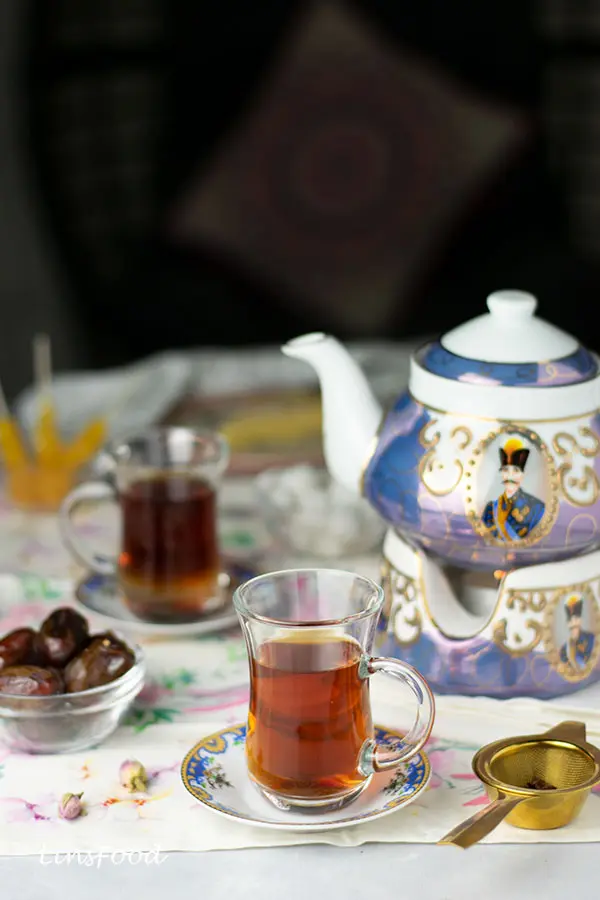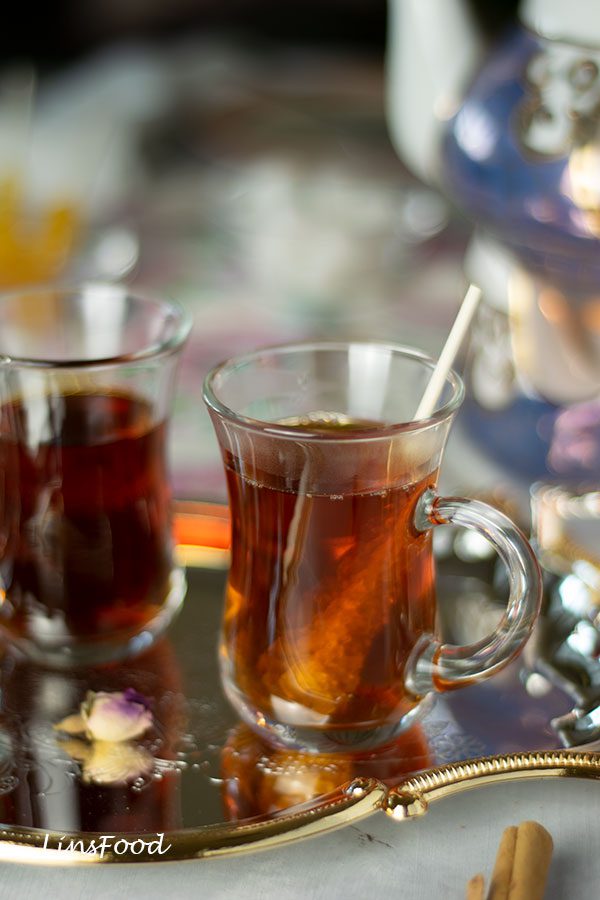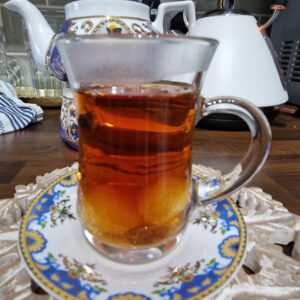Estimated reading time: 8 minutes
Table of contents

What is Persian Tea?
Persian tea is really just black tea, sweetened or unsweetened and perhaps lightly flavoured in different ways. Disregarding the flavourings, Persian tea is just like regular black tea served in many other cultures.
However, what makes Persian tea different is the ritual involved in brewing it, as well as the fact that it is served in small glasses rather than tea cups. This is to allow us to truly appreciate that gloriously rich amber colour. This, and the samovar, is very much a Russian influence.
Like in so many other cultures around the world, drinking tea is a national pastime in Iran. Morning, noon, night and everywhere in between, is always the right time for drinking tea. Like the South Asians and Brits.
I start my mornings with masala chai, made the South Asian way. In the afternoons, I almost always have chaii shirin, Persian sweet tea, more below.
Ghahve Khaneh (Coffee House)
You’ll find many an Iranian meeting up with friends in local tea houses called Ghahve Khaneh after a hard day’s work, for lunch, for breakfast and for no reason at all. Much like North Africans in their tea houses and Singaporeans in Kopi Tiams. Click to read more.
Interestingly, like kopi tiam, ghave khaneh also means coffee house.
- Ghaveh = coffee
- Khaneh = house
The introduction of coffee to Persia is believed to have happened around the 16th century (Encyclopedia Iranica). It was the go-to drink for a long long time, initially as medicine, then with the upper classes before spreading to the masses.
However, sometime in the 19th century, tea started gaining popularity, usurping coffee as the drink of choice in these coffee houses. So despite the name, ghaveh khaneh are very much tea houses.

How to Brew Persian Tea
As you can see in the very first image on this page, Persian tea would traditionally have been prepared in a samovar, the tall, brass container. Just like the Russians. Mine is years old, bought second hand at an antiques market and I love to use it when having friends over. Call me a show off!
Samovar means self cooking, and it’s basically filled with water that’s kept heating away. The little teapot you see sitting above it contains very strong tea. And as you’ll see below, you pour a little of the strong tea into a glass, then top it up with hot water to achieve the right strength.
Old Samovars used coal to heat up the water. This is still practised in the odd tea house in Iran, when you leave the city.
So let’s take a look at how to brew Persian tea at home, sans samovar, shall we? First of all, you need loose tea leaves. Let’s face it, if you love your tea, that’s what you should be using anyway, right? Tea bags only ever produce insipid tea, short on aroma, short on flavour and short on strength. Even if you use 2 bags per cup.

This is how:
- Put the kettle on with 500ml/2 cups of water and place the tea in your chosen teapot.
- Pour the hot water all over your tea leaves, cover with the lid, and place a folded tea towel over the teapot, to reduce the amount of escaping steam.
- Leave to brew for 5 minutes, or 10 for a stronger tea.
- Put the kettle back on with about 1 litre/4 cups water. This water needs to be kept hot as it will be used to top up the tea.
- Pour the tea through a strainer into your chosen tea glasses to about the ¼ mark. Top with the hot water above.
You can adjust the strength of your tea by reducing or increasing the initial amount of tea in the glass (before adding water).
The idea is you to keep topping your glasses with the tea in the teapot and the hot water, both of which will need to be kept warm. I have various teapot warmers at home for this purpose, electric and the more enchanting ones that use tea lights.
What Tea to Use
As mentioned earlier, it has to be loose tea leaves. If you have access to Persian tea, then by all means use that. But in all honesty, you can use any black tea that you regularly use, whatever its strength.
I tend to make my Persian sweet tea with a mix of English Breakfast and Darjeeling or Earl Grey, depending on my mood. Persian tea is drunk black, and when I drink tea black, I don’t like it too strong, so I start with a weaker blend.
But if you like your tea strong, Ceylon Tea or Kenyan tea are the best options. These 2 are what I use in my morning masala chai, with a touch of Darjeeling for the aroma. They both have a beautiful deep colour and robust flavour. My grandma was a big fan of Ceylon tea, and it’s what I drank most often in Singapore.

Flavouring your Persian Tea
So just like the South Asian masala chai, Persian tea can also be flavoured. Here are some ideas of how to flavour Persian tea:
- dried rose buds or petals (or rose water)
- orange peel (or orange flower water)
- saffron
- cardamom
- cinnamon
The above ingredients add a wonderful, subtle aroma and flavour to your Persian tea. Add them in the teapot, along with your tea leaves and leave them to infuse the tea while it’s brewing. Don’t use them all at once though, 1 or 2 complementary ingredients is the way to go.
For example:
- rose + cardamom
- cardamom + cinnamon
Chaii Shirin
I have chaii shirin almost every afternoon around 4pm. It’s both my pick me up and a reminder to take a break from work and stretch a little! Because by that time, I’ve usually been at the laptop a few hours.
What is chaii shirin?
- chaii = tea
- shirin = sweet
So, sweet tea.
Chaii is pronounced almost the same way as the South Asian chai, with just a little more emphasis on the second syllable. So cha – ii, as it’s spelt. So the second syllable is a short ee sound.
Shirin is pronounced as it’s spelt too, shee – reen.

Chaii shirin is simply Persian sweet tea, which can also be flavoured with rose, saffron et al. You just add sugar to sweeten the tea once it’s served in the little tea glasses.
In fact, a very traditional and popular way of serving Persian tea is with saffron flavoured sugar sticks, as you can see in the images here. You sweeten the tea and flavour it at the same time. I always have these sticks at home because I love the ritual.
Layered Chaii Shirin
An old, fun way of making chaii shirin is by creating 2 layers. First, you add 2 tsp of sugar to your glass; more or less, to taste, I like my Persian tea pretty sweet. Then, pour a little hot water and stir to dissolve the sugar.
Next, tilt the glass onto its side, and very slowly pour some tea out of the teapot. When done, straighten the glass and you should have 2 layers, as in the image below. This is more a fun practice that looks pretty to serve. To drink the chaii shrin, you’d just stir it to mix.

How to Serve Persian Tea
Persian tea is always served with something sweet on the side. That can be the customary dates or the more mainstream cakes and cookies.
Have sugar cubes on the side too (or regular sugar) so folks can sweeten their tea if they want to. Or impress them by getting your hands on those saffron sugar sticks.
And there you have it, everything you need to know on how to brew Persian tea at home.
Shall we get our aprons on?
If you enjoy the recipe, drop me a comment and let me know. And if you are feeling like a star, don’t forget that 5-star rating! 😉 Merci!
If you make this recipe, post it on Instagram or Facebook and tag me @azlinbloor with the hashtag #linsfood.
Lin xx

Persian Tea Recipe (+ Chaii Shirin)
Equipment
- 1 kettle or something to boil water in
- 1 teapot or jug
- 1 tablespoon
- 4 small clear heatproof glasses
- 1 strainer
- 2 teapot warmers, optional for keeping tea and water warm
- 1 tea towel
Ingredients
- 2-3 Tbsp loose black tea like Ceylon or English breakfast 3 if you like strong black tea
- 500 ml water for brewing tea
- 1 litre water (roughly) for topping up
Flavourings (1 or 2 at a time, see article)
- 10 rose buds or 1 tsp rose water
- 1 tsp dried orange peel or 1 tsp orange flower water
- 5 saffron strands or the saffron sugar sticks to serve
- 3 cardamom pods, split
- 1 cinnamon stick
Chaii Shirin
- 2 Tbsp loose black tea like Ceylon or English breakfast
- 500 ml water for brewing tea
- 1 litre water for topping up
- white sugar as needed 1-2 tsp per person, each serving (that's 2-4 sugar cubes)
Instructions
- Put the kettle on with the 500ml (2 cups) of water and place the 2 Tbsp tea leaves in the tea pot.

- When the water is boiling, pour it over the tea leaves, along with any flavouring you may be using. Cover with the lid and place a tea towel over the top of the tea pot and brew for 5 minutes. Or 10 if you want a stronger tasting tea with a more pronounced tannin flavour.If using rose or orange flower water, stir it in at the end of brewing time.

- While the tea is brewing, put the kettle back on with the second batch of water.
- When the tea is done brewing, pour it into 4 glasses through a strainer, reaching only ¼ of the way up. Or ⅓ or halfway up for stronger tea.

- Top up with water. Add sugar if desired for chaii shirin, Persian sweet tea.

Layered Chaii Shirin (see video)
- Brew the tea as in steps 1 and 2 above.
- Place 1 tsp or 2 cubes of sugar in your tea glass. Pour hot water up to the ¼ mark and stir to dissolve the sugar.
- Tilt your glass and very slowly pour the brewed tea in, straightening the glass gradually as it fills up.

I am loving that samovar. Like you I too like to collect such antique stuff, they are so good and yes sometimes a show off is good :-). I would love to flavour this tea with orange, and try it.